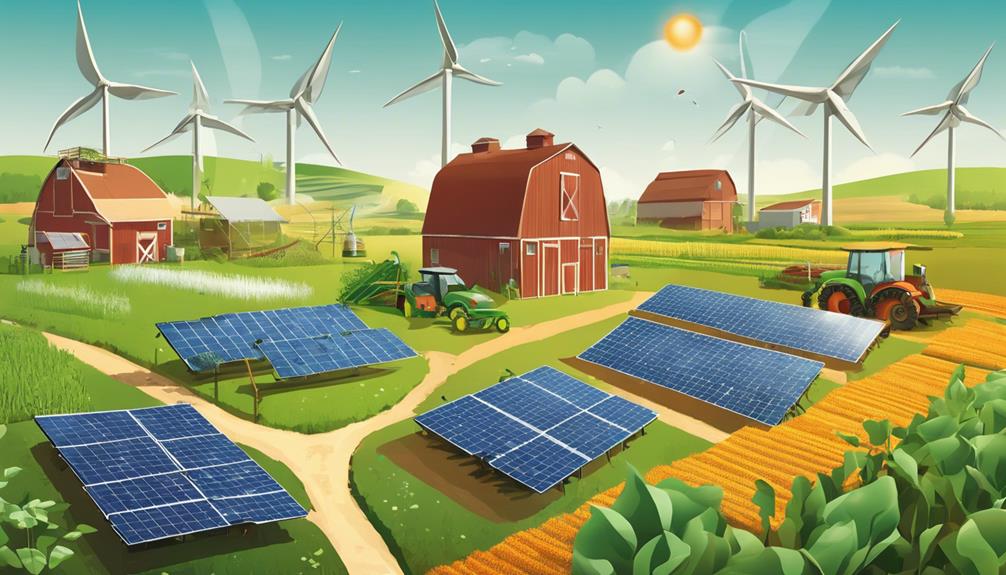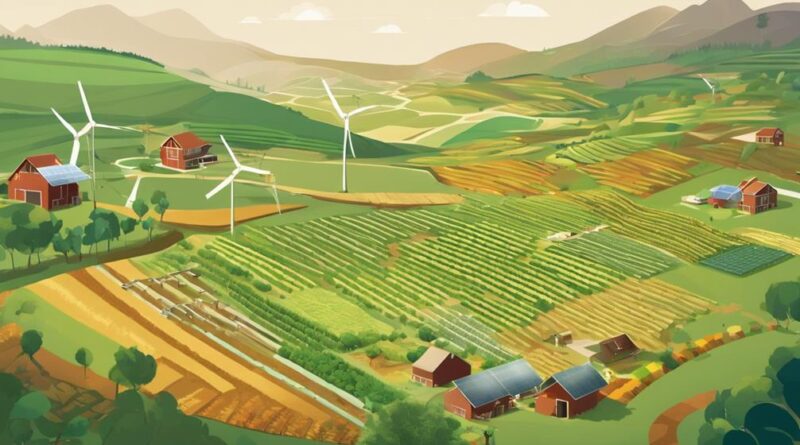Why Choose Farming Methods for Climate Change Adaptation?
When adapting to climate change, choosing farming methods centered on sustainability is key. Opt for organic farming for improved soil fertility and biodiversity. Reduce your carbon footprint with green tech solutions and carbon sequestration practices. Enhance soil health through regenerative farming and water conservation techniques. Develop resilience to extreme weather events with diverse cropping and farm infrastructure improvements. Embrace sustainable food production methods like crop rotation and agroforestry. Engage with communities to boost adaptive capacity and knowledge exchange. By choosing these methods, you can build resilience against climate change impacts on agriculture.
Benefits of Organic Farming
When considering methods for climate change adaptation, organic farming offers a range of benefits that contribute to sustainable agriculture practices. Organic farming focuses on maintaining soil fertility through natural processes, such as crop rotation, composting, and the use of organic fertilizers. These practices help improve soil structure, water retention, and nutrient availability, creating a more resilient and productive farming system in the face of changing climatic conditions.
In terms of pest management, organic farming relies on integrated pest management (IPM) strategies that emphasize prevention and biological control methods over the use of synthetic pesticides. By promoting biodiversity on farms and creating habitat for beneficial insects and other natural predators, organic farmers can effectively manage pest populations while minimizing harm to the environment and human health. This approach not only reduces the ecological footprint of agriculture but also ensures the long-term sustainability of food production systems.
Research has shown that organic farming practices not only help mitigate climate change by sequestering carbon in the soil but also enhance the overall resilience of agroecosystems to extreme weather events and other climate-related challenges. By prioritizing soil health and biodiversity conservation, organic farming offers a promising pathway towards climate change adaptation and sustainable food production.
Reduced Carbon Footprint
Reducing the carbon footprint is a crucial aspect of sustainable farming practices aimed at mitigating climate change effects and promoting environmental stewardship. Implementing green technology solutions is key to achieving this goal. By utilizing renewable energy integration and sustainable practices, farms can significantly reduce their carbon emissions.
One effective method to reduce the carbon footprint in agriculture is through carbon sequestration. This process involves capturing and storing carbon from the atmosphere in the soil, plants, and trees. Practices such as agroforestry, cover cropping, and reduced tillage help sequester carbon, thereby offsetting greenhouse gas emissions.
Integrating renewable energy sources like solar panels, wind turbines, and biogas digesters can further lower carbon emissions on farms. These technologies not only reduce reliance on fossil fuels but also contribute to a more sustainable energy mix.
Adopting sustainable practices such as crop rotation, organic farming, and precision agriculture can also play a significant role in reducing the carbon footprint of farming operations. These practices not only help sequester carbon but also improve soil health and biodiversity.
Enhanced Soil Health
To enhance soil health in agricultural systems, implementing regenerative farming practices is essential for promoting long-term sustainability and productivity. Regenerative farming focuses on improving soil fertility and enhancing nutrient cycling, which are crucial components for maintaining healthy soils. By adopting practices such as cover cropping, crop rotation, and reduced tillage, farmers can significantly enhance soil health.
Soil fertility is a key aspect of soil health, as it determines the soil's ability to support plant growth. Regenerative farming practices help improve soil fertility by increasing organic matter content, which provides essential nutrients for plants. Additionally, these practices promote beneficial microbial activity in the soil, further enhancing nutrient availability for crops.
Nutrient cycling is another vital process for maintaining soil health. It involves the movement and recycling of nutrients within the soil, ensuring that plants have access to essential elements for their growth and development. Regenerative farming techniques such as intercropping and composting facilitate nutrient cycling by optimizing the use of organic matter and minimizing nutrient losses from the system.
Water Conservation Practices
Effective water conservation practices play a crucial role in sustainable agriculture by optimizing water use efficiency and preserving this vital resource for future generations. One key practice that significantly contributes to water conservation in agriculture is drip irrigation. Drip irrigation delivers water directly to the roots of plants, minimizing evaporation and runoff compared to traditional overhead irrigation systems. Research has shown that drip irrigation can reduce water usage by up to 50% while increasing crop yield by providing the right amount of water at the right time.
Another important water conservation practice is rainwater harvesting. By collecting and storing rainwater for later use in irrigation, farmers can reduce their reliance on groundwater and surface water sources. Rainwater harvesting systems can range from simple rain barrels to more complex storage tanks integrated into farm infrastructure. Utilizing harvested rainwater not only conserves water but also reduces energy costs associated with pumping water from distant sources.
Incorporating drip irrigation and rainwater harvesting into farming practices not only ensures efficient water use but also contributes to the overall sustainability of agricultural operations. These practices can help farmers adapt to changing climate conditions, mitigate water scarcity risks, and promote long-term environmental stewardship. By implementing these water conservation methods, farmers can play a proactive role in safeguarding water resources for future agricultural needs.
Biodiversity Preservation
Preserving biodiversity on farms is paramount for ensuring ecosystem resilience and sustainable agricultural practices. Ecosystem restoration and wildlife conservation play crucial roles in maintaining the balance of natural systems. By preserving diverse plant and animal species on farms, you contribute to the overall health of the ecosystem.
Ecosystem restoration involves the active management of land to improve its ecological functionality. This can be done by reintroducing native species, creating wildlife corridors, and implementing sustainable land management practices. By restoring ecosystems on farms, you enhance biodiversity, improve soil health, and increase resilience to environmental changes.
Wildlife conservation is another essential aspect of biodiversity preservation. By providing habitats and resources for various wildlife species on farms, you help maintain the delicate balance of ecosystems. Wildlife such as pollinators, predators, and decomposers play vital roles in agricultural productivity and sustainability. Encouraging biodiversity through wildlife conservation practices can lead to increased crop yields, pest control, and overall ecosystem health.
Resilience to Extreme Weather
Enhancing farm infrastructure for climate resilience is crucial in mitigating the impacts of extreme weather events. With changing weather patterns becoming more erratic due to climate change, farmers need to adapt their practices to withstand these challenges. One effective strategy is promoting crop diversity within farms. Diverse crops have different tolerances to weather conditions, making the farm more resilient to extreme events such as droughts, floods, or heatwaves.
Research suggests that crop diversity can enhance a farm's ability to cope with varying weather patterns. For example, if a particular crop is sensitive to excessive rainfall, having other more resilient crops can help mitigate the losses caused by flooding. Moreover, diverse cropping systems can improve soil health and reduce the risk of crop failure during unpredictable weather conditions.
Sustainable Food Production

To ensure long-term food security in the face of climate change, sustainable food production practices must be prioritized. Implementing crop rotation is a key strategy in sustainable agriculture. By alternating the types of crops grown in a particular field seasonally, soil health is maintained, pests are naturally controlled, and nutrient depletion is minimized. This practice not only enhances soil fertility but also reduces the need for chemical fertilizers and pesticides, lowering the environmental impact of farming.
Agroforestry techniques, another vital aspect of sustainable food production, involve integrating trees and shrubs into agricultural landscapes. This approach offers numerous benefits such as improved soil structure, increased biodiversity, and enhanced water retention. Agroforestry systems provide habitats for beneficial organisms, mitigate greenhouse gas emissions through carbon sequestration, and contribute to climate change adaptation by enhancing ecosystem resilience.
Research indicates that sustainable food production practices like crop rotation and agroforestry not only increase agricultural productivity but also build resilience against climate-related challenges. These methods promote efficient resource use, reduce reliance on external inputs, and foster biodiversity within farming systems. Embracing sustainable approaches to food production is essential in adapting to the changing climate while ensuring food security for present and future generations.
Community Engagement
Integrating local communities into agricultural decision-making processes fosters sustainable practices and enhances the resilience of food production systems in the face of climate change. When engaging with the community, it's essential to focus on farmer education and stakeholder involvement to ensure that agricultural practices align with local needs and environmental conditions. This approach not only empowers farmers with the knowledge and skills needed to adapt to changing climate patterns but also encourages a sense of ownership and responsibility towards sustainable farming practices.
- Local Partnerships: Collaborating with local organizations and institutions can provide access to valuable resources and expertise that can enhance the community's adaptive capacity.
- Resource Sharing: Sharing tools, seeds, and knowledge among community members can help optimize resource utilization and promote collective learning and innovation.
- Inclusive Decision-Making: Involving farmers and community stakeholders in decision-making processes ensures that the implemented strategies are contextually relevant and widely accepted.
- Capacity Building: Providing training and workshops on climate-smart agricultural practices can improve the community's resilience and mitigate the impact of climate change on food production.
- Knowledge Exchange: Facilitating platforms for knowledge exchange and peer-to-peer learning can foster a culture of continuous improvement and adaptation within the community.
Conclusion
In conclusion, opting for farming methods that prioritize climate change adaptation, such as organic farming, can yield a multitude of benefits.
From reducing carbon footprint to enhancing soil health and promoting biodiversity, these practices not only contribute to sustainable food production but also build resilience to extreme weather events.
By embracing these methods, we can work towards a more environmentally conscious and resilient agricultural sector for a sustainable future.
